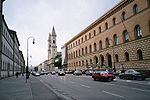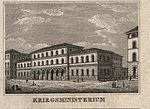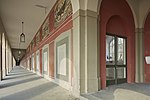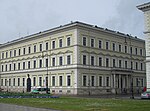Herzog-Max-Palais
Demolished buildings and structures in GermanyDemolished buildings and structures in MunichFormer palaces in GermanyNeoclassical architecture in GermanyNeoclassical architecture in Munich

Herzog-Max-Palais was a neoclassical palace at Ludwigstraße 13 in Munich, Germany. It belonged to the House of Wittelsbach, and was built from 1828 to 1830 for Duke Maximilian Joseph in Bavaria, father of Empress Elisabeth of Austria. In 1937, the palace was destroyed by the Nazi Party in order to widen the Ludwigstraße. The successor construction was started in 1938 by Heinrich Wolff for the Reichsbank and was completed in 1951 for the Deutsche Bundesbank.
Excerpt from the Wikipedia article Herzog-Max-Palais (License: CC BY-SA 3.0, Authors, Images).Herzog-Max-Palais
Ludwigstraße, Munich Maxvorstadt
Geographical coordinates (GPS) Address Nearby Places Show on map
Geographical coordinates (GPS)
| Latitude | Longitude |
|---|---|
| N 48.1458 ° | E 11.5787 ° |
Address
Deutsche Bundesbank - Hauptverwaltung München
Ludwigstraße 13
80539 Munich, Maxvorstadt
Bavaria, Germany
Open on Google Maps







